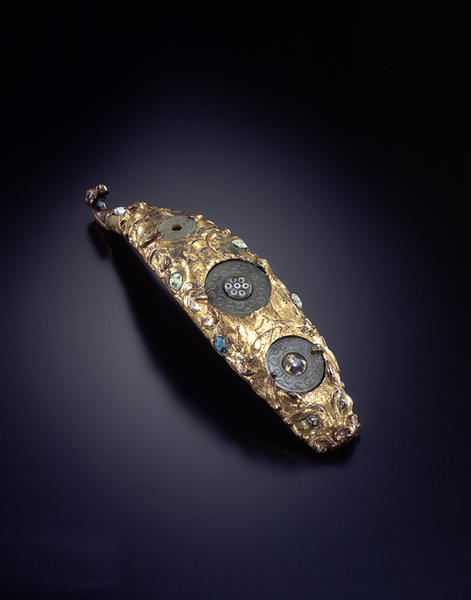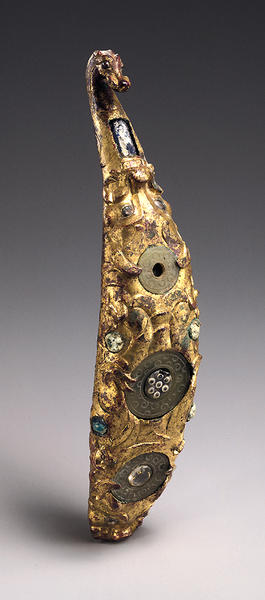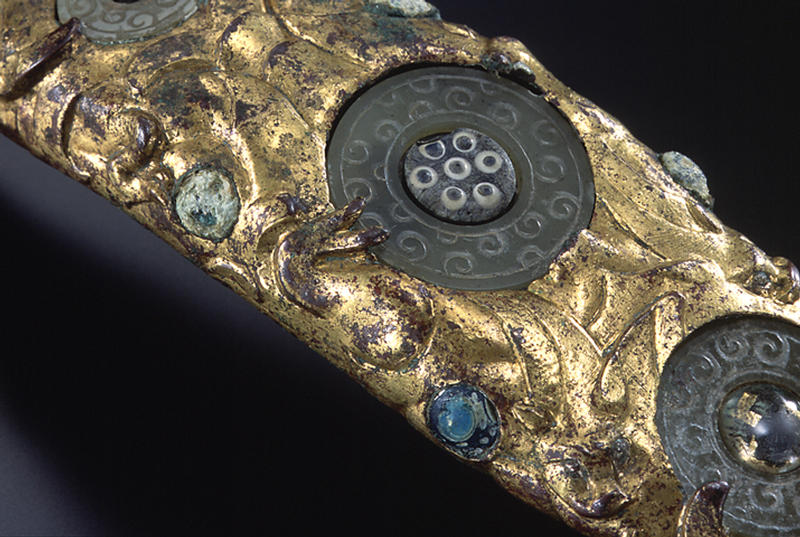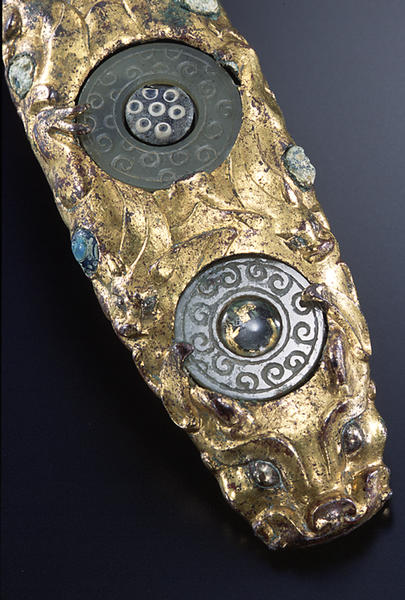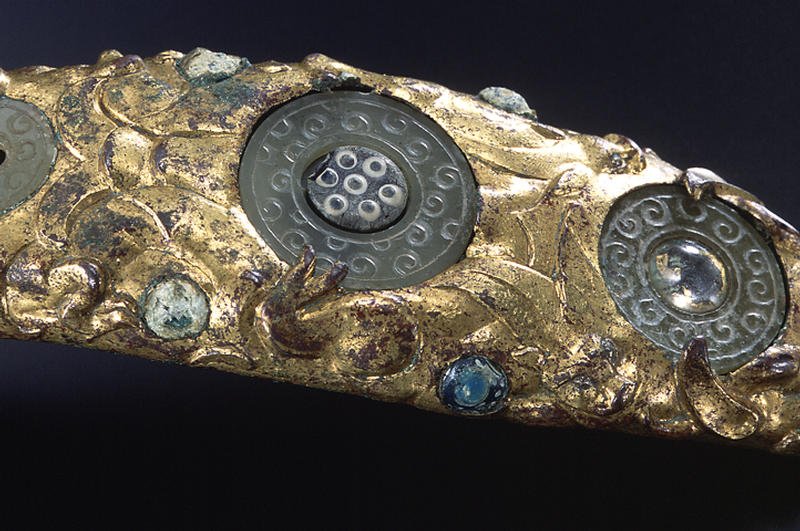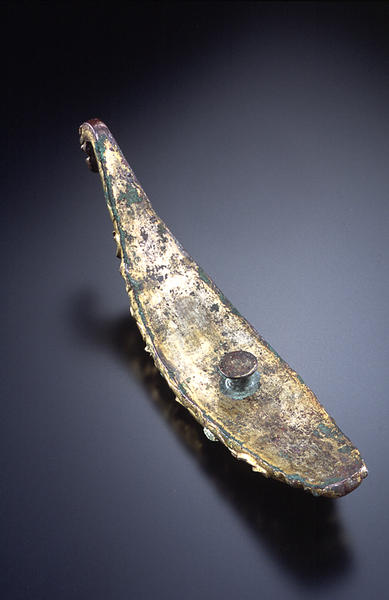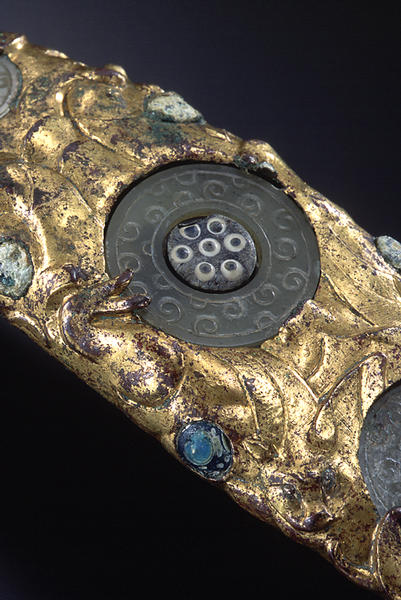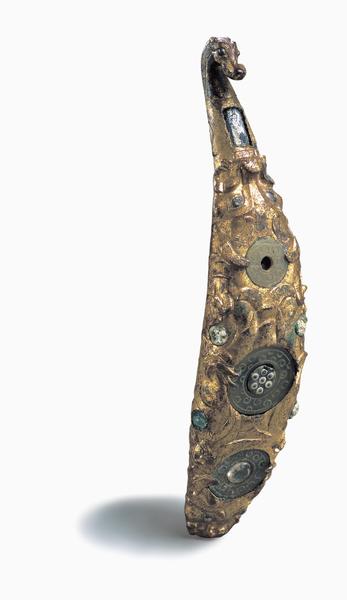玉琉璃象嵌帯鉤
- 中国
- 中国・東周時代
- 前4-前3世紀
- 青銅、金箔、銀箔、エレクトラム、玉、ガラス、水晶
- H-22.2
この大型の弓なりになった帯鉤は中空で蝋型によって鋳造され、表面でうねりをみせる絡み合った龍のような形の複雑な連なりをもっている。鉤の部分は先の細くなった龍頭形をしており、これよりずっと大きな龍の口からのびた、長い首の上にのっている。大きい方の龍の体は、帯鉤の反対側の端に頭のある、鼻先の短い生き物の体と融合している。青銅の表面は水銀で箔鍍金されたのち、龍体の数カ所に、非常に美しい刻線によってさらに加飾され肌のきめを描写している。それと対照をなす二頭の龍の眼は銀箔を上に張って強調され、その接着にはおそらく水銀が用いられた。帯鉤の背面は、エレクトラム箔の水銀鍍金を施したのち、表面の上をとても見事な線彫り
で、曲がりくねって進む龍があらわされた。
帯鈎の体部の両端に龍頭が付き、一端の龍は口から鈎形に作られた小龍の首を吐いている。小龍喉首には藍色柱形ガラス、帯鈎体部両側面には2つずつ同心円文を施した透明青緑色珠が嵌められている。体部中央には三璧が縦一列に嵌められているが、下端の璧には裏に金箔を貼った半球形の水晶が嵌められ、中央の璧には深藍.・白色の七星文をその平らな頭に施されたリベット型の深藍色ガラスが嵌め込まれている。さらに帯鈎の表裏とも細かい刻線で龍体の細部や鳳凰の姿が描かれている。
Catalogue Entry
Ornate belt hooks such as this example were a product of the third century B.C. By the end of that century they were out of fashion and are not found in later burials.1 A large belt hook with a similar symmetrical dragon design was discovered in Tomb M5 at Guweicun, Hui Xuan, Henan province.2
This large arched belt hook was hollow cast by the lost-wax process with an intricate medley of intertwined dragon-like forms that appear to undulate over the surface. The hook itself is cast in the shape of an attenuated dragon head on a long neck, which emerges from the mouth of a much larger dragon, whose body merges with that of a short-muzzled creature whose head is placed at the opposite end from the hook.
The bronze surface was mercury foil gilded. After gilding, it was further enriched by very fine engraved lines that lend texture to certain areas on the dragons' bodies. By contrast, the two sets of eyes were accented with a silver foil overlay, most probably adhered by mercury. The back of the belt hook was engraved with a very fine linear design of a sinuous dragon that curls and coils its way over the surface after being mercury foil gilded using electrum. (Electrum is a naturally occurring alloy of gold and silver that ranges in color between shiny white and pale yellow.) A round stud for attachment is set in the middle of the back.
Three annular jade disks engraved with spiral motifs mark the spine of the wide, bulging body of the belt hook and are held in place by various dragon appendages. The spirals on the disks are carved in such a way that no adjacent spirals turn in the same direction, a feature also noted on a late-Warring States jade in the Freer Gallery of Art, Smithsonian Institution, Washington, D.C.3 There are four colorful glass inlays: a blue one in the rectangular cell below the hook; one in the central holes of the middle of the three jade disks; and two on each side of the body of the belt hook. The glass set into the middle disk is dark blue and has a rosette design of seven white-rimmed blue eyes. It has a projecting stem underneath that fits into the central perforation in a jade disk set below the top disk, anchoring it in place. The disk in the lower part of the garment hook is set with a polished hemispherical rock crystal backed with gold foil. The inlay for the top disk is missing, but remnants of what was probably a jade disk are visible.
ECB
1. Lawton 1982, pp. 122-23, no. 72; Wang 1985, fig. 3.2.
2. Hui Xian fajue baogao 1956, p. 104, fig. 123, pl. 74; Yang 1987, pl. 23.
3. Lawton 1982, p. 172, no. 123.
